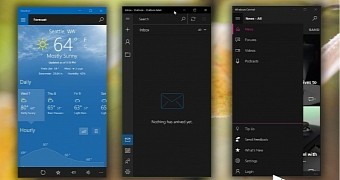CShell, also referred to as Composable Shell, is Microsoft’s internal project that could save Windows phones, as it represents a single universal shell that would adapt to each device and provide the same look, feel and features for all users.
This means that Windows phones could finally get an experience that’s closer to the one on a PC, and changes that were included by Microsoft in an accidentally-released build provide us with a closer look at how the whole thing is going to work.
WindowsCentral managed to install the build on an HP Elite X3 and see how Continuum has been overhauled, with Microsoft reportedly aiming to make the desktop experience as similar as possible to the one you’re getting on a PC.
This means that thanks to these updates, when you start working on a phone with Continuum, you should feel more like working on a PC with Windows 10, with the two platforms to be brought closer together as part of the CShell project we were telling you about.
New Continuum improvements
First and foremost, Continuum will now come with the fully-featured Windows 10 taskbar, with a system tray and everything. There will be icons for the Action Center, Wi-Fi, and battery, just like you’d be working on a laptop with Windows 10.
The Start button, Cortana, and Task View icons will still be there, while Microsoft will provide users with additional customization options for the Start menu, despite the fact that this will basically emulate the Start of their Windows phones. Users will be allowed to resize tiles, turn live tiles on or off, and even re-position the taskbar on the screen as you do on a PC.
Customization options will also be offered for the rest of the operating system, like accent colors for the taskbar, Action Center, and title bar, and settings to change the wallpaper will finally be available.
Window mode will make it to the next version of Continuum as well, which means that users will be able to multitask just like they’re supposed to do on a Windows device. Options to resize windows or snap them side by side will also be offered, similar to the PC experience.
Fluent Design will make it to Continuum to mimic the PC experience and the typical copy and paste features will also be offered. Drag and drop between apps is also likely to be included, though it’s not yet ready at this point.
Unfortunately, there’s no ETA as to when this new experience is expected to be available, but the good news is that Microsoft is still working on something big on the mobile front. We’ll hear more about the mobile overhaul in the summer, when bigger changes are expected to make it to insiders.

 14 DAY TRIAL //
14 DAY TRIAL //